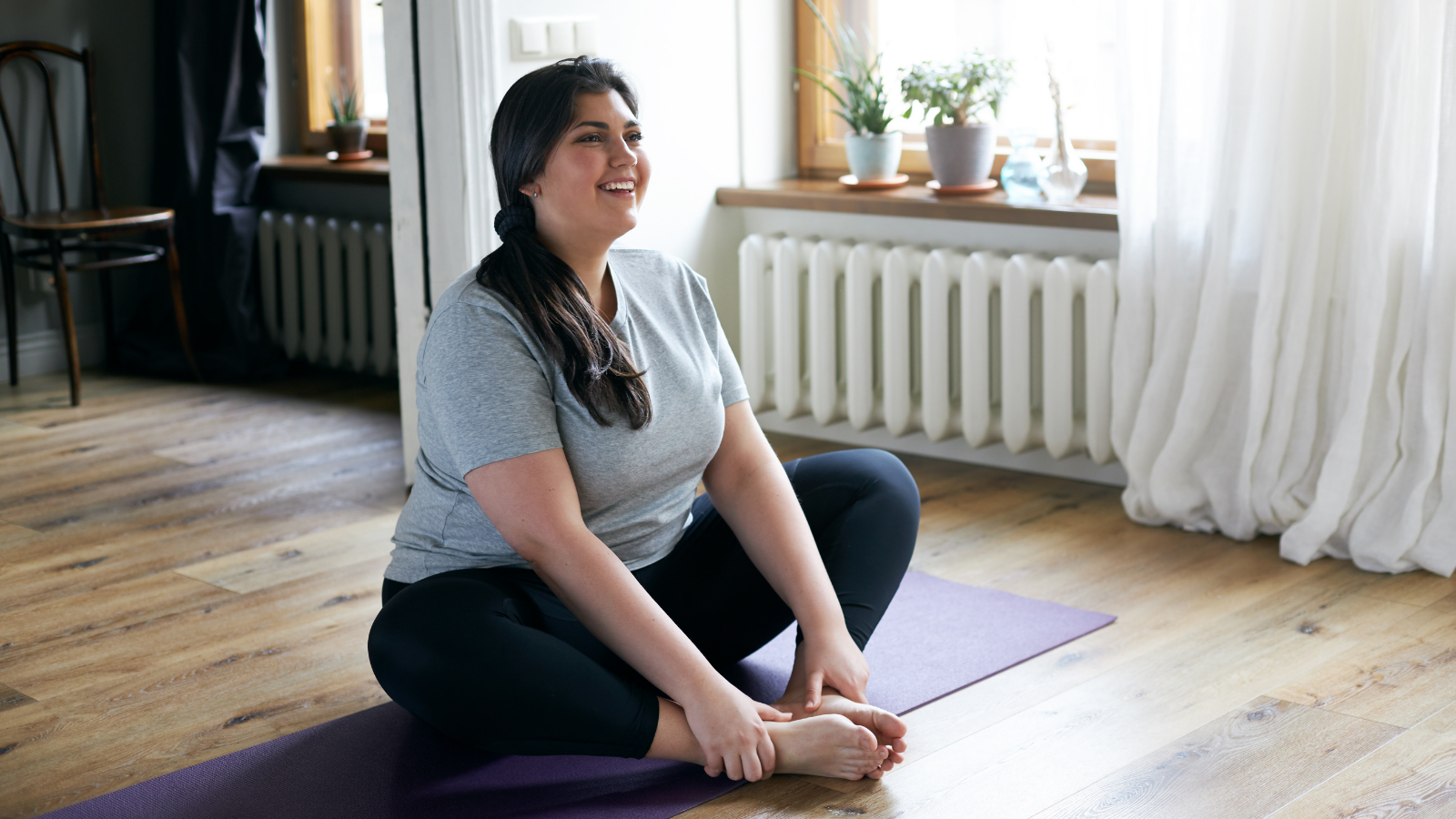View basket (0 items $0.00)

Yogic Wisdom: How to Make Peace with Food
What if I told you to forget every diet rule and healthy eating tip you’ve ever tried to adhere to, and just eat what you want when you want it?
If you’re anything like me, you may have an adverse reaction to that level of freedom and choice when it comes to food. My head wants to scream, but we need all of those rules to tell us what, when, and how much to eat to stay healthy and fit.
Or do we?
Not according to the concepts and philosophy of intuitive eating, an evidence-based approach to food that rejects diet mentality and the entire notion that thinner equals better and healthier, shifting the focus to overall well-being. (1)
Intuitive eating was originally developed 25 years ago by two nutritionists to help people heal from the emotional, psychological, and physical side effects of chronic dieting. The practice has gained mainstream popularity and media attention as of late thanks to the growing backlash to diet culture, and its most recent incarnation, the clean eating movement.
Intuitive Eating, Yoga and The Self

Rather than following external food rules (or feeling shame and guilt when you can’t), intuitive eating is about listening to the internal cues of your body to determine what, when and how much to eat. Ultimately it’s about being in tune with your body’s unique needs, trusting your inner wisdom, having self-compassion, and making peace with food.
If you’re thinking that sounds awfully familiar to the aim of yoga, you’re right. Both yoga and intuitive eating are considered journeys of self-exploration that aim to cultivate a stronger mind/body connection while developing more compassion for oneself (and others). Yoga is the attunement of mind, body, and soul, while intuitive eating is the attunement of mind, body, and food. Both are paths of personal empowerment.
"People are tired of feeling at war with their own bodies,” says Evelyn Tribole, RDN who, with Elyse Resch, RDN, co-authored Intuitive Eating: A Revolutionary Program That Works. One of the core principles of intuitive eating is body respect, or learning to accept (or at least become more neutral about) your body regardless of how you feel about its shape or size once you stop dieting and start eating intuitively.
Ah, the art of self-acceptance. What’s more yogic than that?
How to Discover a Happier, Healthier Way to Eat

Intuitive eating has emerged as the anti-diet because it breaks free from the food police and the endless pursuit to be thin. It promotes a healthier, happier approach to food.
What long-term research has shown us is that restrictive dieting doesn’t work. While some can lose the desired amount of weight, very few are actually able to keep the weight off. In fact, many studies show that food restriction and dieting can actually lead to more weight gain.
What’s worse, is that diet culture and the obsession with weight leads to body dissatisfaction and fatphobia, negatively impacting our health and wellbeing. Research has shown that inflexible adherence to eating rules and dietary restrictions are associated with body image inflexibility, as well as eating psychopathology and other more general psychopathology conditions, such as depression.
In other words, being so focused on eating the “right” foods all of the time and being the “right” size and shape (that is according to our society’s diet-obsessed culture) makes most of us unhappy. Yet so many women, myself included, base their happiness on their weight. Meanwhile, the majority of us aren’t satisfied with their body image. Something’s got to give.
Enter: intuitive eating.
Study after study shows that intuitive eating leads to not only a better relationship with food but also to a better relationship with your body. A systematic review of 24 studies found that intuitive eating is strongly associated with less disordered eating, including bingeing, and a more positive body image, as well as increased optimism, greater emotional resilience, and overall health and wellbeing.
Yoga, the Mind-Body Connection, and Intuitive Eating

Intuitive eating is the most natural approach to food. That is before we filled our heads with the fearful, anxiety-laden, and shame-ridden messages we’ve received from diet culture. That being said, it takes time, patience, and most likely counseling to override the endless barrage of messages and rules pervasive in diet culture and eat according to your body’s own internal cues.
Think about when you were a child before you were told sugar was “bad” for you and were inundated with the messages that thinner is better, more lovable, more deserving, healthier, and even happier. You most likely ate when you were hungry, stopped when you were full, and didn’t concern yourself with the shape and size of your body. There was no guilt, no shame, no counting calories, no “good” or “bad” foods, and no food stress.
That’s essentially what intuitive eating is; however, just like when you were a baby, it’s eating for physical rather than emotional reasons. Intuitive eating is all about understanding your physiological and psychological cues, and how you respond. These include eating when you feel hungry, stopping when you feel satiated, and learning to cope with tough emotions with compassion and kindness rather than distracting yourself by mindlessly eating.
Meant to empower the individual, intuitive eating cultivates stronger body awareness as you get to know your body’s cues (what hunger, satisfaction, and fullness feel like), followed by unconditional permission to eat. No food restrictions or diet plans, and no shame or guilt.
Worried you’ll just eat cookies or chips all day every day? Don’t be. Research shows that when people stop adhering to food restrictions and start paying attention to the way they feel, the desire to binge out on their favorite junk foods lessens and they naturally migrate to more nutritious food like whole grains, protein, and vegetables.
Also, read this article from Meagan McCrary - Yoga Anatomy: Tone Your Vagus Nerve to Combat Inflammation.
 Meagan McCrary is an experienced yoga teacher and writer with a passion for helping people find more comfort, clarity, compassion, and joy on the mat and in their lives. She is the author of Pick Your Yoga Practice: Exploring and Understanding Different Styles of Yoga a comprehensive encyclopedia of prominent yoga styles, including each system’s teaching methodology, elements of practice, philosophical and spiritual underpinnings, class structure, physical exertion, and personal attention. Currently living in Los Angeles, Meagan teaches at the various Equinox Sports Clubs, works privately with clients, and leads retreats internationally. You can find her blog, teaching schedule, and latest offerings at www.MeaganMcCrary.com.
Meagan McCrary is an experienced yoga teacher and writer with a passion for helping people find more comfort, clarity, compassion, and joy on the mat and in their lives. She is the author of Pick Your Yoga Practice: Exploring and Understanding Different Styles of Yoga a comprehensive encyclopedia of prominent yoga styles, including each system’s teaching methodology, elements of practice, philosophical and spiritual underpinnings, class structure, physical exertion, and personal attention. Currently living in Los Angeles, Meagan teaches at the various Equinox Sports Clubs, works privately with clients, and leads retreats internationally. You can find her blog, teaching schedule, and latest offerings at www.MeaganMcCrary.com.
Resources
-
Bruce LJ, Ricciardelli LA. (2016). A systematic review of the psychosocial correlates of intuitive eating among adult women. Appetite.96:454-472. DOI: https://doi.org/10.1016/j.appet.2015.10.012
-
Duarte C., Ferreira C., Pinto-Gouveia J., Trindade I.A., Martinho A. (2017). What makes dietary restraint problematic? Development and validation of the Inflexible Eating Questionnaire. Appetite. 114:146-154.
-
O’ Hara L. and Taylor J. (2018) What’s Wrong with War on Obesity? A Narrative Review of the Weight-Centered Health Paradigm and Development of the 3C Framework to Build Critical Competency for a Paradigm Shift. SAGE Open: Apr-June: 1-28. DOI: https://doi.org/10.1177/2158244018772888
-
Rothblum E. (2018). Slim Chance for Permanent Weight Loss. Archives of Scientific Psychology:6, 63–69. DOI: http://dx.doi.org/10.1037/arc0000043
Featured Courses









